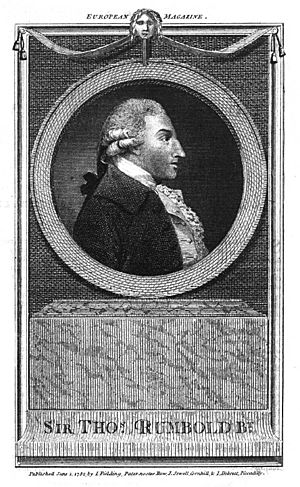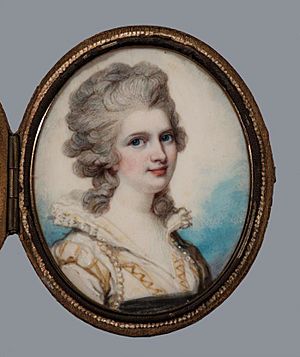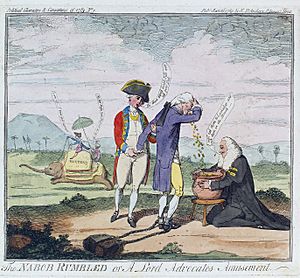Thomas Rumbold facts for kids
Quick facts for kids
Thomas Rumbold
|
|
|---|---|
 |
|
| Governor of Madras | |
| In office 8 February 1778 – 6 April 1780 |
|
| Preceded by | John Whitehill |
| Succeeded by | John Whitehill |
| Personal details | |
| Spouse | Joanna Law |
Sir Thomas Rumbold, 1st Baronet (born January 15, 1736 – died November 11, 1791) was a British leader in India. He was also a politician who served in the House of Commons from 1770 to 1790. He held the important position of Governor of Madras (a region in India) from 1777 to 1780. During his time, he became very wealthy, which led to questions about how he earned his money. He brought a large fortune back to Britain.
Contents
Early Life and Career
Thomas Rumbold was the third son of William Rumbold. His father was an officer in the East India Company's navy. At 16, Thomas joined the company as a "writer," which was a clerk. Later, he moved into the company's military service.
Military Service in India
In 1757, he was promoted to Captain. He worked as an aide to Robert Clive during the famous Battle of Plassey. This battle was a key moment for the British in India. After his military service, he returned to the company's civil (non-military) work. He became a chief in Patna in 1763. From 1766 to 1769, he was a member of the Bengal Council.
Return to Britain and Politics
By 1769, Rumbold had returned to Britain with a lot of money. He understood that having influence in Parliament was important for the East India Company. In 1770, he was elected to Parliament as a Member of Parliament (MP) for New Shoreham. This area was known for difficult elections.
He faced challenges getting elected. Many votes were questioned because of accusations of bribery. However, after a review, he was declared the winner. At first, he voted against the government. But by 1773, he began supporting the government's decisions about India, just like his former commander, Robert Clive.

Election Challenges
In the 1774 election, Rumbold was involved in another election issue in Shaftesbury. He and another candidate were initially declared elected. However, their opponent complained, showing evidence that money had been given to voters. It was suggested that Rumbold and his colleague had paid voters.
The Parliament committee decided to overturn the election result. They also ordered that Rumbold and others should be investigated for bribery. However, this investigation never fully happened. Later, Parliament changed its mind, allowing Rumbold to run for election again in 1780.
Governor of Madras
Meanwhile, Rumbold continued his work with the East India Company. He was a director of the company from 1772, and again from 1775 to 1777. In June 1777, he was appointed Governor of Madras.
Key Events as Governor
During his time as governor, British troops took control of Guntur (which was then French territory). This area was soon added to Madras. His troops also captured Pondichéry and Mahé. He reported these successes to Lord North, a powerful British leader. For his achievements, he was made the first Baronet of Wood Hall in March 1779. This title referred to his estate, Woodhall Park, in England.

Challenges and Resignation
Sir Thomas was also involved in talks with Haidar Ali, a powerful Indian ruler. However, he could not stop Haidar Ali from invading the Carnatic. This led to the Second Anglo-Mysore War. Rumbold resigned as governor in 1780 due to health reasons.
After his resignation, the East India Company removed him from their service. They believed he was responsible for the Carnatic invasion and the war. A parliamentary investigation was also about to begin. Rumbold wanted to be in Parliament to defend himself. He had lost his seat in Shaftesbury again due to election issues. So, he bought a seat in Yarmouth (Isle of Wight). At that time, paying someone for a seat in Parliament was allowed, even though bribing voters was not.
Parliamentary Investigation
Rumbold supported the idea of a parliamentary committee to look into the causes of the war in the Carnatic. He spoke many times during the discussions. However, the committee did not ask him to give evidence. Eventually, they proposed to formally accuse him of wrongdoing.
It was suggested that he had taken a very large amount of money for himself. It was shown that he had sent much more money back to England than his salary allowed. But Rumbold defended himself strongly. No clear evidence against him came from India, and he was eventually found not guilty.
Later Life and Legacy
Rumbold continued to serve as an MP until 1790. He passed away the following year.
Burial and Art
Sir Thomas Rumbold was buried at Watton-at-Stone. There is a monument to him in the local church. He was also painted by famous artists of his time:
- Thomas Gainsborough painted "Thomas Rumbold and his Son." This painting is now in the Victoria Art Gallery.
- Reynolds painted a portrait of him, which is at the Art Institute of Chicago.
- Romney painted a portrait that is in the Hunterian Art Gallery.
Family
His oldest son, William Richard Rumbold, died before him. So, his son George became the next baronet. George was a diplomat. Another son, Charles, also served as an MP for Great Yarmouth.
His daughter, Elizabeth Anne, tried to improve her father's public image. She wrote a book about him that was published after she passed away in 1868.

